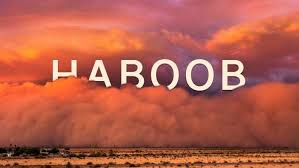
haboob
Introduction: What is a Haboob?
A haboob is one of nature’s most dramatic and breathtaking weather events. Derived from the Arabic word meaning “blasting” or “drifting,” a haboob is essentially an intense dust storm caused by strong winds that kick up massive walls of dust and sand, often reaching thousands of feet into the air. While haboobs can occur in many desert regions across the world, they are especially common in Arizona, where hot, dry conditions meet sudden monsoon winds.
If you’ve ever seen a Phoenix dust storm rolling across the desert, you know how intimidating these walls of dust look. They transform the sky from blue to brown within minutes, blocking visibility, disrupting flights, causing APS power outages, and forcing drivers to pull over on highways. For people unfamiliar with desert life, seeing a haboob in Phoenix for the first time feels like a scene straight out of an apocalyptic movie.
But haboobs aren’t just about dramatic visuals. They are dangerous weather events that can cause traffic accidents, health risks, and infrastructure damage. That’s why meteorologists track them closely, issuing dust storm warnings when conditions are favourable. In places like Phoenix, Arizona, where monsoon season brings both rain and dust, knowing how to react when a haboob strikes is a matter of safety.
The Science Behind a Ha boob
Understanding a ha boob in Arizona starts with understanding its science.
How Haboobs Form
Haboobs are formed during thunderstorms when downdrafts of cold air rush down to the desert floor. As the air spreads outward, it picks up loose dust, dirt, and sand, creating a fast-moving wall of particles. These dust walls can travel for miles at speeds of 30–60 mph, engulfing entire cities in minutes.
Why Arizona Experiences Them Frequently
Arizona, especially the Phoenix area, is particularly vulnerable to haboobs because of its desert geography and weather patterns. The soil is loose and dry, perfect for being swept up into the air. Combine that with powerful winds from monsoon thunderstorms, and you have the perfect recipe for dust storms.
Connection to Monsoon Season
Most haboobs in Arizona occur during the summer monsoon season, which typically runs from mid-June through September. During this period, moisture surges into the region, triggering thunderstorms that can collapse into massive dust storms. It’s not uncommon for Phoenix weather in July or August to flip from sunny skies to haboob conditions in a matter of minutes.
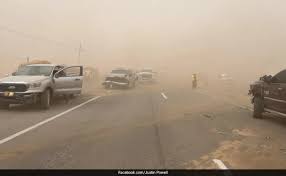
Haboobs in Arizona: A Unique Desert Phenomenon
Arizona is famous for many things—Grand Canyon sunsets, saguaros, and scorching summers. But Arizona dust storms are another defining feature of desert life.
Arizona’s Geography and Climate
The state’s flat desert basins, surrounded by mountains, create natural wind tunnels that amplify the strength of haboobs. The dry soil around Phoenix and Tucson is highly erodible, making it easy for winds to pick up dust.
Phoenix as the Epicentre of Dust Storms
When people talk about haboobs in Arizona, they often mean Phoenix haboobs. Phoenix, being the largest metropolitan area in the state, frequently experiences these dust storms firsthand. Residents are used to receiving a dust storm warning on their phones or seeing dramatic images of a dust storm in Phoenix today trending online.
Notable Arizona Haboobs in History
One of the most infamous Phoenix dust storms occurred in July 2011, when a massive wall of dust more than 5,000 feet high swept across the city. The storm halted air travel, caused multiple traffic accidents, and left thousands without power. Videos of that storm went viral, making “haboob Phoenix” a trending phrase worldwide.
More recent storms, including those in 2018 and 2021, continue to remind Arizonans that haboobs are not just rare events—they’re an annual reality.
The Impact of Haboobs on Phoenix
Phoenix, Arizona’s capital and most populated city, often finds itself in the direct path of these storms.
Phoenix Weather Patterns
During the summer, Phoenix weather is notoriously extreme—scorching daytime highs above 110°F and sudden monsoon storms in the evenings. These thunderstorms often collapse into dust storms, making Phoenix haboobs a regular occurrence.
Phoenix Dust Storm Today: Real-Time Experiences
Whenever a haboob hits, local news stations and weather apps light up with alerts like “Phoenix Dust Storm Today.” Social media fills with dramatic photos and videos of walls of dust swallowing downtown Phoenix. For newcomers, the experience can be terrifying; for long-time residents, it’s a reminder of the desert’s power.
APS Power Outage Risks During Storms
Another big impact of Phoenix dust storms is the risk of APS power outages. Dust and debris can damage electrical infrastructure, leaving thousands of homes without power in the middle of scorching heat. APS (Arizona Public Service) often deploys emergency crews immediately after a storm to restore electricity.
Dust Storm Warnings and Safety Precautions
Dust storms may be fascinating to watch from afar, but up close, they’re dangerous. That’s why dust storm warnings are a vital tool for safety.
How Dust Storm Warnings Are Issued
The National Weather Service issues a dust storm warning when conditions are favorable for a haboob. In Arizona, these warnings often accompany monsoon thunderstorms. Residents in Phoenix receive alerts on their phones, radios, and TVs telling them to seek shelter and avoid driving.
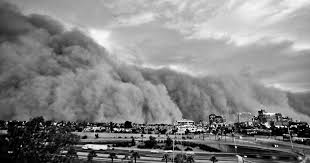
Driving Safety During a Phoenix Dust Storm
One of the greatest dangers during a Phoenix haboob is driving. Visibility can drop to zero within seconds, leading to dangerous multi-car pileups. Safety officials always remind drivers: “Pull Aside, Stay Alive.” This means pulling completely off the road, turning off lights, and keeping your foot off the brake until the storm passes.
Protecting Homes and Health
Dust storms also carry health risks, especially for people with asthma or respiratory issues. During a haboob in Arizona, it’s best to stay indoors with windows closed. Using air purifiers and wearing masks can help reduce dust exposure. Homeowners are advised to secure outdoor furniture and cover pools to minimise storm damage.
Health Risks Associated with Haboobs
While haboobs in Arizona may look spectacular in photos and videos, they come with real health dangers. The massive clouds of dust they carry aren’t just made of harmless dirt; they often contain pollutants, bacteria, fungi, and microscopic particles that can cause respiratory issues.
Respiratory Concerns
Dust particles from a Phoenix dust storm are small enough to penetrate deep into the lungs. People with asthma, COPD, or other respiratory conditions may experience flare-ups, difficulty breathing, or even hospital visits after exposure. Health experts often warn residents to limit outdoor activity when a dust storm warning is issued.
Valley Fever Risks
One unique health hazard tied to Arizona dust storms is Valley Fever, a fungal infection caused by spores found in desert soil. When haboobs sweep through the region, these spores can become airborne. Inhaling them may lead to flu-like symptoms such as fever, cough, and fatigue. In rare cases, Valley Fever can become a serious medical condition requiring long-term treatment.
Eye and Skin Irritation
The fine dust from a haboob in Phoenix can also irritate the eyes, causing redness, dryness, or infections. People caught outside may feel dust scratching against their skin, leading to rashes or discomfort. Protective eyewear and masks are strongly recommended during Arizona dust storms.
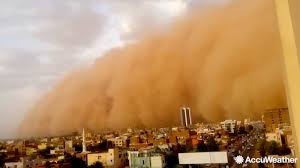
Haboobs and Transportation Disruptions
Haboobs don’t just affect people’s health—they also create major problems for transportation across Arizona.
Highway Hazards
The biggest transportation risk is on Arizona’s highways, especially the I-10 corridor between Phoenix and Tucson. Drivers often underestimate how quickly visibility can disappear during a Phoenix dust storm. Within seconds, roads can go from clear to zero visibility, leading to pileups involving dozens of vehicles.
Safety campaigns like “Pull Aside, Stay Alive” aim to reduce fatalities. The Arizona Department of Transportation urges drivers not to try to “outrun” a dust storm in Phoenix but instead pull over safely and wait it out.
Air Travel Disruptions
Airports, especially Phoenix Sky Harbor International Airport, also feel the effects of haboobs. A large haboob in Arizona can delay or ground flights, as pilots must avoid low visibility conditions and dangerous crosswinds. Videos of airplanes attempting to land during a dust storm often circulate on the news and social media.
Public Transit and Local Roads
Local bus and rail services in Phoenix are sometimes delayed during storms. Power outages caused by APS infrastructure damage can also shut down traffic lights, leading to gridlock throughout the city.
Power Outages and Infrastructure Damage
A haboob in Phoenix isn’t just a natural spectacle—it’s a threat to infrastructure.
APS Power Outages
One of the most common side effects of a Phoenix dust storm is a widespread APS power outage. When strong winds and flying debris hit power lines, thousands of homes can lose electricity in the middle of Arizona’s blistering summer heat. Without air conditioning, residents face dangerous temperatures indoors.
APS crews work around the clock during monsoon season to restore power. Storm recovery costs run into millions of dollars each year, and utility companies continually upgrade systems to withstand future dust storms.
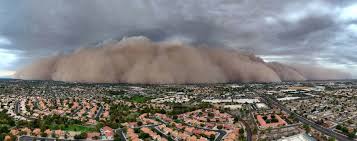
Damage to Buildings and Property
High winds from haboobs can rip roofs from houses, topple fences, and scatter outdoor furniture. Pools become filled with dust and debris. Businesses often shut down temporarily when haboobs roll through Phoenix, especially if power goes out.
Communication Systems
Dust storms may also disrupt communication networks. Cell towers can be damaged, and in severe cases, even internet services may be interrupted. This makes it harder for residents to receive dust storm warnings in real-time.
Capturing the Haboob: Videos and Media Impact
Every time a haboob in Arizona occurs, it quickly makes headlines—not just locally, but globally.
Social Media Frenzy
Thanks to smartphones, every major Phoenix haboob is captured on video within minutes. Platforms like Twitter, Instagram, and TikTok light up with dramatic clips of walls of dust swallowing freeways, stadiums, and downtown Phoenix.
News Coverage
News stations across the U.S. frequently feature Arizona dust storms as dramatic weather events. When a Phoenix dust storm today makes the evening news, the footage often goes viral, reminding viewers outside Arizona of the desert’s extreme conditions.
Cultural and Artistic Inspiration
Haboobs have also inspired photographers, filmmakers, and even musicians. The visual impact of a towering wall of dust rolling across the desert landscape has been featured in documentaries, movies, and weather specials.
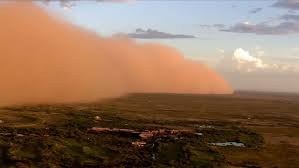
Monsoon Season: The Source of Arizona’s Haboobs
At the heart of every haboob in Phoenix lies the monsoon season, Arizona’s annual weather phenomenon.
What is Monsoon Season?
From June to September, Arizona experiences dramatic weather changes as moist air from the Gulf of Mexico and the Pacific Ocean moves into the state. This surge of moisture fuels thunderstorms, flash floods, and—of course—dust storms.
Why Haboobs Are Linked to Monsoons
Haboobs form when powerful thunderstorm downdrafts hit the desert floor, creating massive outflows of wind. Since monsoons bring frequent thunderstorms, they naturally increase the number of dust storms. This is why Arizona haboobs are almost always a summer phenomenon.
Monsoon in Phoenix: A Double-Edged Sword
For residents, the monsoon season is both a blessing and a curse. On one hand, it provides relief from scorching heat and replenishes groundwater. On the other, it brings destructive floods and towering Phoenix dust storms that create chaos for transportation and power systems.

